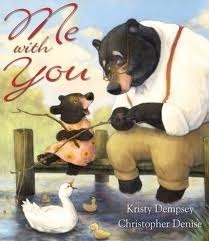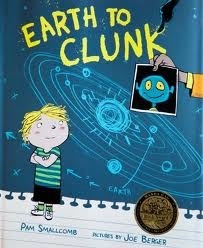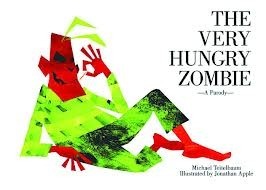Picture Book University: Nontraditional Storytelling

Welcome back! I hope you almost feel like a picture book expert by now. Through the last three weeks, you should have read no less 40 picture books. That's amazing, isn't it? If you've missed the previous lessons, just click here: PBU Lessons.
This week, I'll be highlighting different ways to tell your story. I'm going to be honest here--illustrators (who are also writers) can normally get away with these types of books as well as very established picture book authors. Since you are straying away from the "traditional" and what editors say they're looking for (which by and large is character driven, funny, quirky books with a surprising twist!), you must have a spectacular idea to turn their heads.. (This can happen, so I don't want to discourage you.)
If you've studied the market at all, you may have noticed some extremely successful books that are told in a surprising way. I'm going to list a few different "types" of books and their examples. This is definitely not exhaustive. I will try to give author only examples as much as I can. Usually, they will be author/illustrator.
 1. Cycle Stories: These stories follow the main character along throughout the day. Normally, they're told from when the child gets up and ends when he goes to sleep, but not always. It can also be told through seasons. Normally, it ends the way it began. Any story can have a cyclical element where the opener mimics the ending. This is a style element, though, not a cycle story. A few examples include Me With You by Kristy Dempsey, Pajama Pirates by Andrew Kramer, Snow! Snow! Snow! by Lee Harper, and Red, White, BOOM! by Lee Wardlaw.
1. Cycle Stories: These stories follow the main character along throughout the day. Normally, they're told from when the child gets up and ends when he goes to sleep, but not always. It can also be told through seasons. Normally, it ends the way it began. Any story can have a cyclical element where the opener mimics the ending. This is a style element, though, not a cycle story. A few examples include Me With You by Kristy Dempsey, Pajama Pirates by Andrew Kramer, Snow! Snow! Snow! by Lee Harper, and Red, White, BOOM! by Lee Wardlaw.2. Journey Stories: This is similar to a cycle story in that there isn't a beginning main problem. The story follows the main character through a series of events. There is a big beginning and there are things that happen throughout the story and there is even a climactic event with the story ending in the journey's end (which often times is a surprising twist), but the traditional story arc is not there. What is intriguing about a story like this is the journey itself. Beautiful language or rhyme can enhance this type of story as well. Tell Me Something Happy Before I Go to Sleep by Joyce Dunbar, Squeak, Rumble, WHOMP! WHOMP! WHOMP! by Wynston Marsalis, and Where is Catkin by Janet Lord.
3. Poetry: This is a story told in poetic form. It can either be describing a concept through a series of poems or telling a tale in rhyme. It can also be one large poem. Always there needs to be a good beginning with a climactic surge at the end and a twist or satisfying ending. Poetic language is key to selling this type of story. Examples include Once Upon a Twice by Denise Doyen, Atlantic by G. Brian Karas, Mirror Mirror: A Book of Reversible Verse by Marilyn Singer, and Pumpkin Butterfly by Heidi Mordhorst.
 4. Cumulative stories: This is where a story is told building upon itself until it gets to a surprising twist ending or it can end in a cyclical way--back to the beginning. A Dog is a Dog by Stephen Shaskan, How Do Dinosaurs Say Goodnight series by Jane Yolen, If You Give a Mouse a Cookie series by Laura Numeroff.
4. Cumulative stories: This is where a story is told building upon itself until it gets to a surprising twist ending or it can end in a cyclical way--back to the beginning. A Dog is a Dog by Stephen Shaskan, How Do Dinosaurs Say Goodnight series by Jane Yolen, If You Give a Mouse a Cookie series by Laura Numeroff.5. Journal entries or diary format: Popular almost ten years ago, many authors have been successful writing these and kids love them. This is a story told through a series of diary entries or letters or journal notes. Examples include Diary of a Worm series by Doreen Cronin, Dear Mrs. LaRue series by Mark Teague, Diary of a Wombat by Jackie French, Memoirs of a Goldfish by Devin Scillina, and Help Me, MR. MUTT! by Janet Stevens and Susan Stevens Crummel. Another take on this that doesn't show only letters but is about correspondence between an alien and a human boy is the delightful Earth to Clunk by Pam Smallcomb.

6. Funny spoofs of classics: This is where an author takes a well known book and puts his/her own twist or spin on it. Many new revisionists include Goodnight Goon, Runaway Mummy by Michael Rex,The Very Hungry Zombie by Michael Teitelbaum, A Creature Was Stirring: One Boy's Night Before Christmas by Carter Goodrich, and Frankenstein by Rick Walton that spoofs the Madeline series.
Assignment 4: Go to a bookstore and peruse the newest titles. Try to find at least one of each of these types of books. Are they written by an author/illustrator or an author only? Any by new authors? What types of trends in picture book storytelling do you see?
If you don't have access to a bookstore, go to your library and check out 2-3 of each type. Which type do you like the best? Is there a type you think you'd like to try? Go for it!
If you like these posts, please don't forget to tell your friends by hitting the twitter bird and liking it on Facebook. A blog mention is always welcome!
Don't forget, I'll be drawing names for my free picture book critique tomorrow. If you want to find out details, click this link: PBU Critique Give Away
Happy perusing!
Published on July 22, 2013 13:13
No comments have been added yet.



